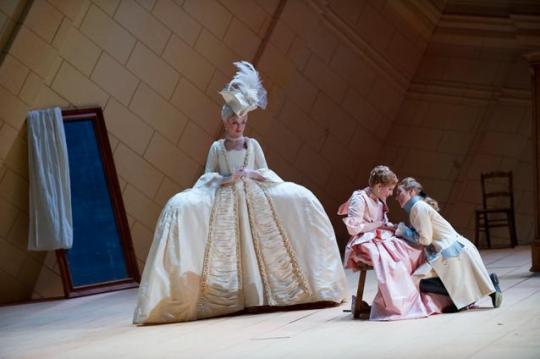#Rosenkavalier
Text
Okay, was anyone going to tell me that Der Rosenkavalier by Strauss was a threesome lesbian opera, or was I just supposed to learn that in a random music history course myself?
In other news, I’ve got a new Frosen Steel au idea.
#the characters are:#young warrior with a rose motif#woman trapped in arranged marriage by rich asshole father#and a kind woman with high ranking military connections#this shit writes itself#ruby rose#weiss schnee#penny polendina#frosen steel#whiterose#nuts and dolts#rwby#der rosenkavalier#opera#rosenkavalier
59 notes
·
View notes
Text

[above: Celine Byrne, Paula Murrihy and Claudia Boyle for Irish National Opera, 2023]
So... I've started a tradition of bringing a group of friends to performances at the Metropolitan Opera and creating illustrated orientation guides to help everyone get prepared for each show. The next one is Richard Strauss & Hugo von Hofmannstal's Der Rosenkavalier, and I'm proud of how the document turned out... even if it does run to 23 pages 😅.
Some excerpts:


Illustration by Al Hirschfeld of the 1982 Metropolitan Opera cast: (L-R)
the Italian tenor, Sophie, the Marschallin, Octavian, Herr Faninal, Baron Ochs

On the final trio:
Musically, the thing that really blew my mind about this number is the way it builds to an unbearably beautiful climax (3:33), then a heartbreaking chord change (3:43), then it feels like gravity turns upside down (3:50), then somehow goes sideways (3:59), then FINALLY resolves (4:10). I’ll never be able to adequately explain how this makes me feel. It blows past all expectations, again and again, and just when you start to catch your breath, the bottom drops out from under you again, revealing a whole new level that you never dreamed was possible.
The most common way to stage this scene is to spread the three singers across the stage, each processing their turbulent emotions alone to the audience. But I also like the staging from Zürich in 2004, which keeps them tightly together and even has the characters touch at key points. It also helps that all three performers look like they’re about to fucking explode.

Feel free to read and share, and let me know what you think!
#opera#Richard Strauss#Hugo von Hofmannsthal#Der Rosenkavalier#Rosenkavalier#opera tag#1910#1911#the 1910s#opera guides#my writing#Celine Byrne#Paula Murrihy#Claudia Boyle#Al Hirschfeld#John Tomlinson#Sarah Connolly#Elīna Garanča#Elina Garanca#Bruno Ravella
11 notes
·
View notes
Text

#The Desert Peach#donna barr#Pfirsich Rommel#Rosenkavalier#my favourite#he's one of a kind#and his silly little song cracks me up everytime#such gibberish!
4 notes
·
View notes
Text
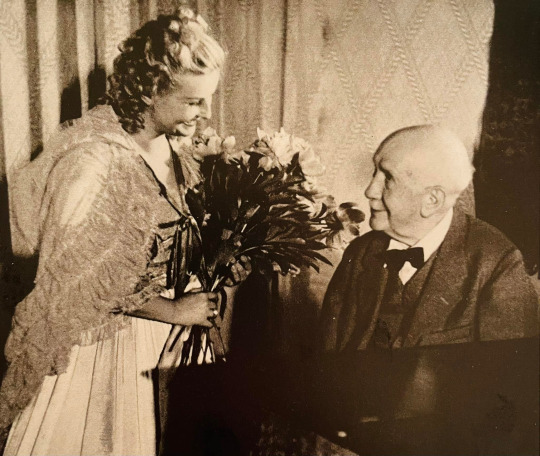
On the 85th birthday of Richard Strauss (1864-1949) a festive performance of his “Rosenkavalier” was played in the Bavarian State Opera. In this picture we see the composer who attended the dress rehearsal together with the soprano Gerda Sommerschuh, who could be heard as Sophie that evening. Richard Strauss died shortly thereafter. At his will, she sang Sophie again in the final trio of the same opera at his funeral.
#Richard Strauss#Strauss#composer#classical composer#conductor#pianist#violinist#Rosenkavalier#opera#bel canto#aria#diva#primadonna#maestro#Gerda Sommerschuh#Sommerschuh#soprano#birthday
3 notes
·
View notes
Text
My Der Rosenkavalier "Princess Rezi" Fanfic Series on AO3 is 17 chapters and counting.
2 notes
·
View notes
Text
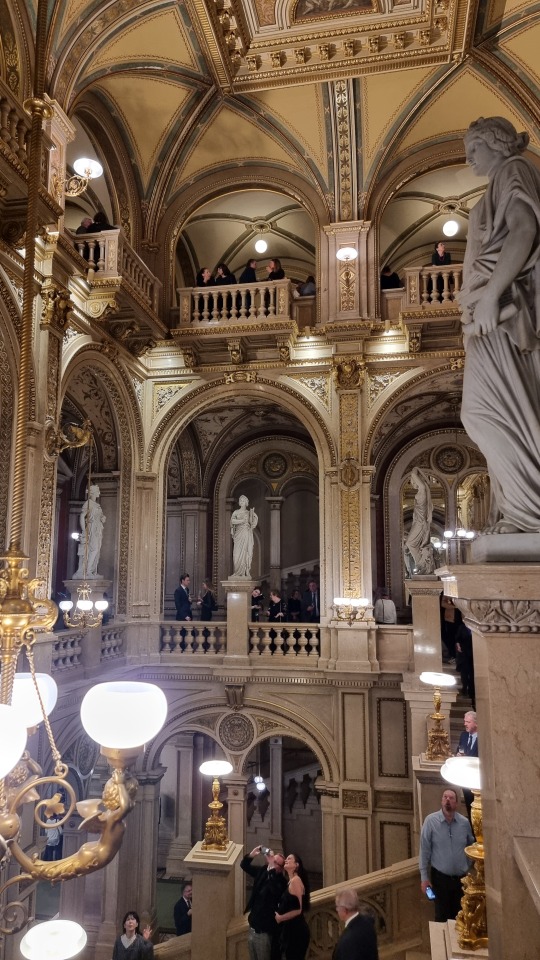
Wien, Donnerstag, 21. März 2024
Staatsoper
Eine Vorstellung des Rosenkavalier besucht. In den Teilen, die den zweiten Weltkrieg überlebt haben, ist das Haus so opulent wie die Musik von Richard Strauss. Leider ist das nur 20 Prozent vom ursprünglichen Bau. Die Haupttreppe, die sogenannte Feststiege, gehört dazu.
1 note
·
View note
Text
youtube
Der Rosenkavalier - Richard Strauss - De Nationale Opera
0 notes
Text
Bayerische Staatsoper 2021/22 - Der Rosenkavalier
Bayerische Staatsoper 2021/22 – Der Rosenkavalier
Foto ©Wilfried Hösl
Il ritorno alla normalità della vita musicale tedesca procede a grandi passi e finalmente il pubblico della Bayerische Staatsoper ha potuto assistere di persona al nuovo allestimento di Der Rosenkavalier (more…)
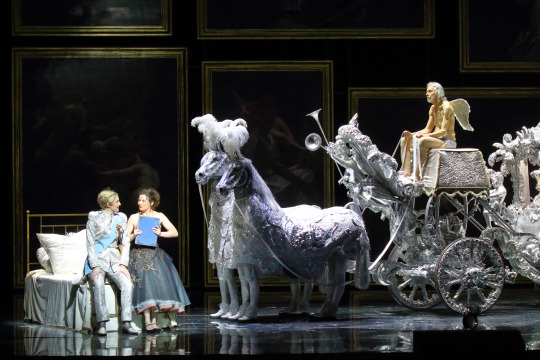
View On WordPress
#barrie kosky#bayerische staatsoper münchen#bayerische staatsorchester#canto#christoph fischesser#critica#johannes martin kränzle#liv redpath#marlis petersen#münchen#novecento#opera#rosenkavalier#samantha hankey#strauss#teatro#vladimir jurowski
0 notes
Text
the opera comment that's like if this is acting I'm glad sutherland never bothered...that's my dream for lise. opera directors stop making her limp and stagger "naturalistically" around the stage and look shorter for her scene partners....please try to understand. she is as petrarch calls laura an "alta colonna" or as mary sidney translates a "stately pillar"....every movement should be how a marble statue would move and every kneeling folding bending embracing etc needs to be absolutely self-willed and an act of grace. this kind of presence is why her strauss roles are so good but we can bring some of this iciness into verdi too. are you taking notes
#actually guiltily have not watched/listened to rosenkavalier with her all the way thru yet....maybe that's up next for me#sp
24 notes
·
View notes
Text

youtube
21 notes
·
View notes
Text

#i made this a while ago idk why i didnt post it#opera tag#der rosenkavalier#don carlos#la clemenza di tito#happy pride month👍im just in time jsjvnekvns
37 notes
·
View notes
Text
In Richard Strauss's Der Rosenkavalier (1911), Octavian, a mezzo dressed as a man (a role Mary Garden refused to create, because of its lesbian implications), presents a silver rose to the soprano Sophie, and the two women seal with a duet their instant infatuation. Drugged by this music, I overvalue passion; I don't ask its name.
When the silver rose arrives, Sophie falls in love with a woman. This lesbian moment depends on roses, which exceed and baffle nomenclature (a rose is a rose is a rose). Duets usually speak the number two; but Gertrude Stein's conundrum suggests that a rose introduces a third term, a third sex, into the two-pronged gender system. The silver rose--and opera itself--carry the charge of an unspeakable and chronology-stopping love because a connection arose in the late nineteenth century between tampering with time and tampering with gender.
Disturb gender, and you disturb temporality; accept the androgyne, and you accept the abyss.
— Wayne Koestenbaum, The Queen’s Throat: Opera, Homosexuality, and the Mystery of Desire.
57 notes
·
View notes
Text

Richard Schubert, the celebrated tenor and interpreter of Richard Wagner's romantic heroes, embodied a new ideal of the Heldentenor. His predecessors - Schnorr von Carolsfeld, Albert Niemann, later Erik Schmedes, Ernst Kraus and Heinrich Knote - were renowned not least for their voluminous physique and commensurate voices. Schubert in turn, bad a clearly focused, shining voice that enabled him to penetrate the mighty forces of a Wagner Orchestra. Especially lauded, however, was bis youthfully ideal stage appearance with which he managed to do full justice to the magic of his roles. Thus it is no surprise that it was Richard Strauss who actually discovered him. In one of the Nuremberg "Rosenkavalier" productions conducted by him the musician accompanying the tenor in the aria of the "singer" attracted his attention because of his extraordinary histrionic ability. Strauss was later told that said flautist was a student who was studying singing in order later to become a baritone. He decided to keep an eye on him. Nevertheles he could hardly have known that this young man was subsequently to become one of the most celebrated Heldentenors of the Vienna State Opera. Initially Schubert sang minor baritone roles in Strassburg; bis well-developed top range soon showed which way bis career was to turn. Eventually he managed the transition to the tenor repertoire and he subsequently sang in Nuremberg, Wiesbaden and Hamburg, learning the most important Heldentenor roles as well as many lyric roles. Even when he was celebrated as a Heldentenor he. still continued to sing lyric roles where he could relax and "oil" his voice. While in Hamburg he owed a lot to Egon Pollack, then the intendant of the opera. There, on December 4, 1920, he also sang the tenor lead in the world premiere of Komgold's "Die tote Stadt", a role in which he was subsequently acclaimed in Vienna. In April 1920 Schubert was engaged to sing five performances in Vienna. His Radames initially did not quite fulfill expectations as the Viennese were accustomed to the huge voice of Leo Slezak. Yet he managed to convince as Walter, Tannhäuser and Pedro in "Tiefland". A further guest appearance in the tetralogy of the Ring finally convinced all and sundry that here was a grandiose successor to Erik Schmedes, whose style, however, recalled rather the latter's predecessor Hermann Winkelmann. Unfortunately, Schubert could only be signed up for brief periods of time in each case which were used for cyclical performances of Wagner operas. Hence his excursions into the lyric repertoire were few and far between. Also in Richard Strauss' operas he was acclaimed. Thus he was an impressive Bacchus in "Ariadne auf Naxos" (convincing, both in appearance and demeanor as the young God - disappointed and hence suspicious after his Circe adventure - and his subsequent metamorphosis into a fiery young lover), an other-wordly Emperor in "Frau ohne Schatten", a neurotic Herod in Salome, a cowardly scheming Aegisth in "Elektra" or a confused but nevertheless determinedly heroic Menelas in "Agyptische Helena". His artistry was evident also as Samson in "Samson et Dalila", Achill in "Iphigenie in Aulis" and Siegnot in Pfitzner's "Rose vom Liebesgarten". One special curiosity worth mentioning is that this Heldentenor was also an elegant and highly flamboyant Eisenstein in "Fledermaus". However, his vital repertoire remained the Wagner oeuvre - from Rienzi to Parsifal. The excessive demands he made on his voice by singing such an exhausting repertoire all over the world led to a vocal crisis in 1927. A recuperation period turned out to be too brief for him to regain his vocal health completely. Nevertheless admiration was widespread how the artist managed to identify with his roles and thus camouflage his vocal deterioration - so much so, in fact that criticism seemed mere carping. In May 1929 he left Vienna but frequently appeared as a guest artist, acclaimed by his numerous supporters - both male and, more frequently, female. The
phenomenon of his charisma was the secret of his artistry. Thus he frequently appeared as Siegfried and in the last phase of his career, more and more often as Eisenstein, a role in which this glorious Heldentenor last appeared in Vienna on February 15, 1937. After terminating his career he started directing operas and ultimately taught singing in Hamburg. He died on October 27, 1958 in Oberstaufen in the Allgäu.
#Richard Schubert#Richard Wagner#Der Freischütz#Carl Maria von Weber#Lohengrin#Tristan und Isolde#Die Meistersinger von Nürnberg#Das Rheingold#Die Walküre#Siegfried#Götterdämmerung#Die Königin von Saba#Rosenkavalier#Richard Strauss#Tannhäuser#Frau ohne Schatten#Salome#Elektra#Die tote Stadt#Aida#Giuseppe Verdi#Samson et Dalila#Camille Saint-Saëns#Rose vom Liebesgarten#Hans Pfitzner
3 notes
·
View notes
Text
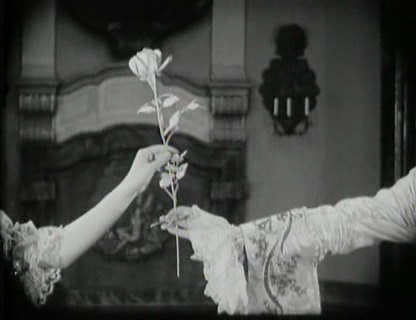
Today we're taking a look at the costume of an OLD period film, where my interest collide: 1920s and the 18th century.
Der Rosenkavalier (1926) is based on the opera of the same name by Richard Strauss, and the music from that is what accompanies this not so silent film. Since the libretto is changed a lot from the one of the opera, the movie also includes music from Strauss' Couperin suite. It was premiered in 10th January of 1926 at the Dresden Semperoper, and Strauss himself conducted the orchestra! Isn't that super cool? You can watch it on YouTube!
The costume design for this film was by Alfred Roller, Hans Rouc, and Stefan Wessely (the three of them usually worked in Art Direction), and Ludwig Rudlof was the wig maker.
I had never thought about this film until I was reading a magazine (a new one, from 1923 LOL), and there was a little column about Jaque Catelain (who plays Octavian in this film) and it had a photo from this film. And OF COURSE that sent me to a rabbit hole. I mean, look at him (and Elly Felicie Berger):

And, now something @vinceaddams always tell us all to look at: LOOK AT THE COAT SHOULDERS!!!!!! That's so good! AND FROM 1926.
Now, I love LOVE LOVE the costumes of this film. Let's take a look!
First of all, we have not one, but TWO robes de cour with the right kind of lace sleeves! One has a more historically accurate neckline, and the general silhouette of the torso. It was worn by Huguette Duflos as the Countess Maria Theresia von Werdenberg (the Marschallin):


And the other has a more square neckline (like in a middle way between a court mantua and a robe de cour), and the torso is less accurate (she doesn't seem to be wearing the right stays, nor the dress having the proper boning), but the petticoat is SPECTACULAR (worn by Elly Felicie Berger, as Sophie):
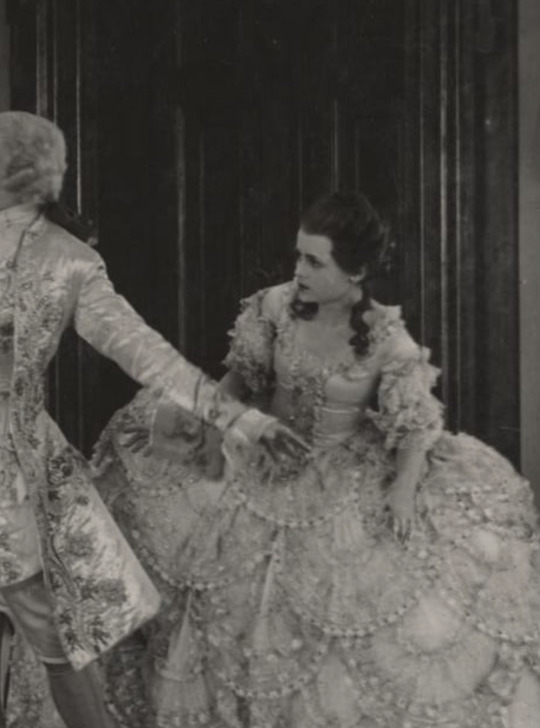
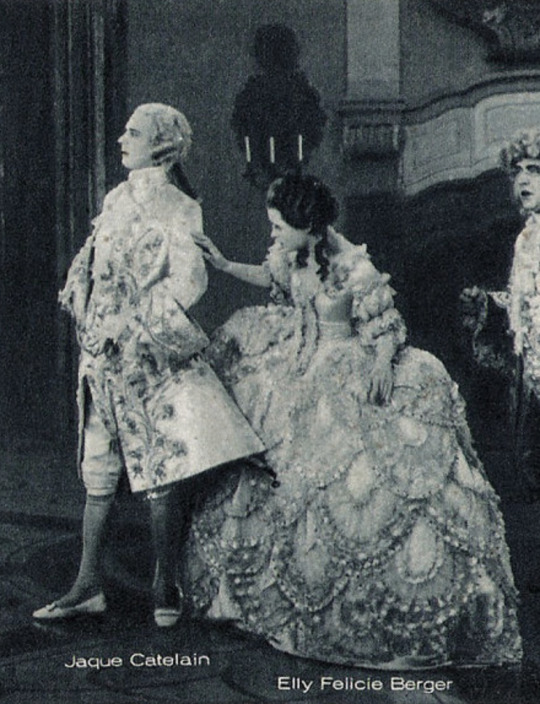

The women have both other dresses:
A robe à la française in stripes for Sophie:
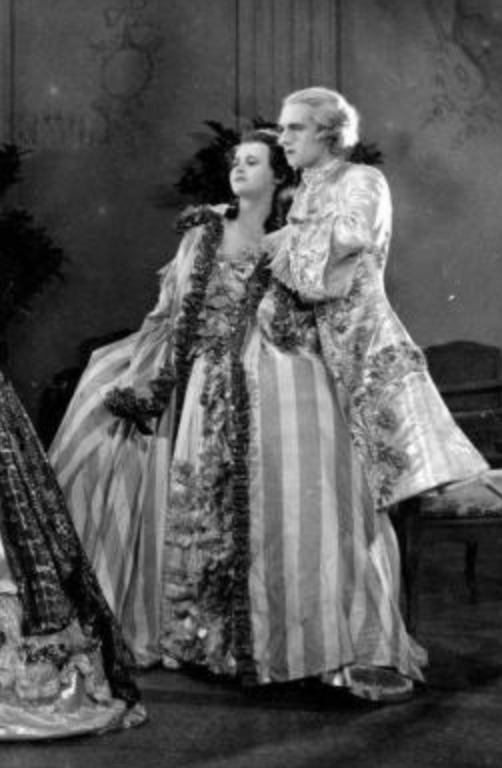
This very flammable looking for the Marschallin:
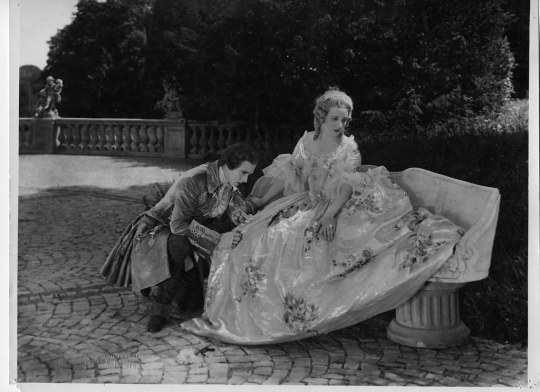
And this one is also a robe de cour (kind of?), but with a petticoat and overskirt that feels more like a robe à la française. I mean, it clearly closes on the back, so I like to think of this dress as a robe de cour.

We also see Carmen Cartellieri wearing... this... dress and a coat/robe over it. This might be the dress that looks more like a halloween costume of the whole film, but honestly, I've seen way worse lately...


Now, let's just enjoy all of the menswear. They have some funny and odd cuff choices, but the general look is WAY better than many MANY modern 18th century set films and series. But the coats, the wigs, the cravats... it is all so pretty!
Here some early 18th century wigs:

LOOK AT THE VOLUME OF THIS FROCK COAT!!! Also, I LOVE that they kept the dark coloured hair of Jaque Catelain as Octavian in some parts:

And in other parts where he's supposed to be dressed nicer, he wears a white wig. This is also my favourite suit of the film, that looks taken straight from a Barbier illustration:


Now let's look at Paul Hartman as the Marschall. The silhouette that he wears is slimmer and fitted closer to the body than the other characters, being it from later in the century.
He wears a court outfit, that has too short breeches and too straight front:

His other main look is this suit with decorative lines, that along the riding boots, gives him the appearance of strict military dude. The front is nicely curved, and even the shoulders have a structured feel that matches the character. That's good costume design, my friends.



Over this outfit, he wears a carrick (or garrick) coat and a tricorn hat:

We also have Michael Bohen (as Ochs von Lerchenau) and Karl Forest (as Herr von Faninal). Their looks are kind of mid 18th century (?) and earlier 18th century kind of mixed together. They have different lengths of waistcoats and one of their coats (the one on Karl Forest) looks earlier to me. But in this comedy of errors, both of them are supposed to be kind of silly, so I accept that they look kind of odd. Still, better than many series I've seen lately.
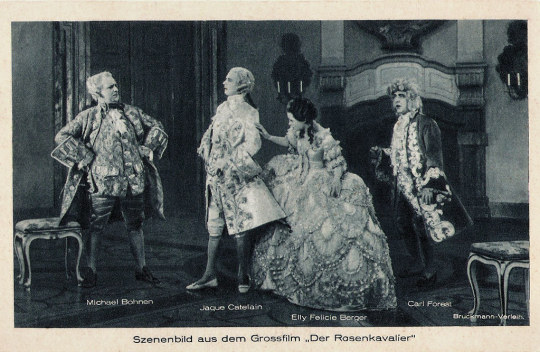

So, to finish this post, here are some images from the film that I didn't use complete before, but you might want to see. Enjoy:
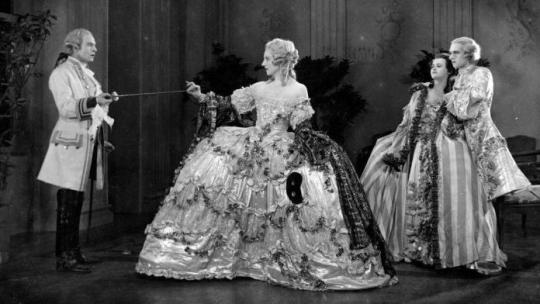


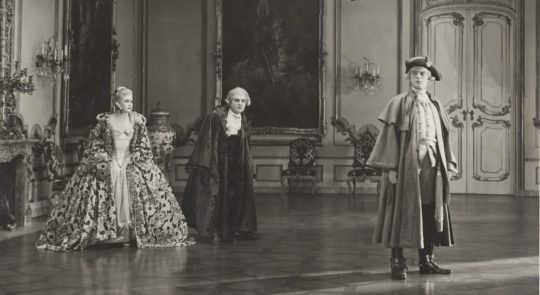
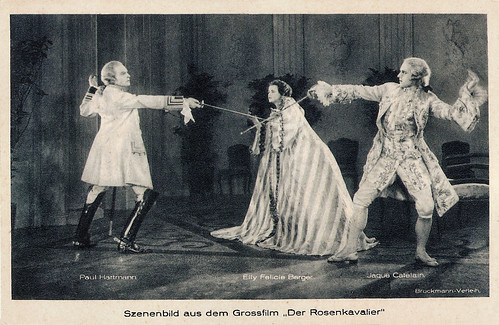

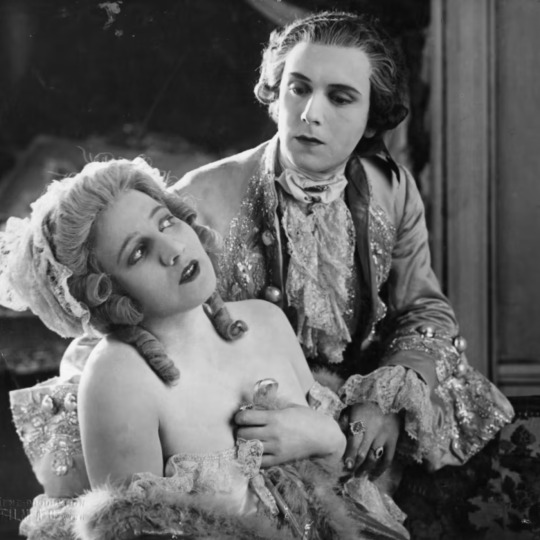
So, what is your favourite outfit from this film?
#1920s#18th century#period drama#opera#richard strauss#der rosenkavalier#the knight of the rose#1926#long post
149 notes
·
View notes
Text
#opera#poll#german opera#die zauberflöte#the magic flute#hansel and gretel#hänsel und gretel#die entführung aus dem serail#the abduction from the seraglio#der fliegende holländer#the flying dutchman#fidelio#salome#der freischütz#der rosenkavalier#ariadne auf naxos#tristan und isolde#tristan and isolde
11 notes
·
View notes
